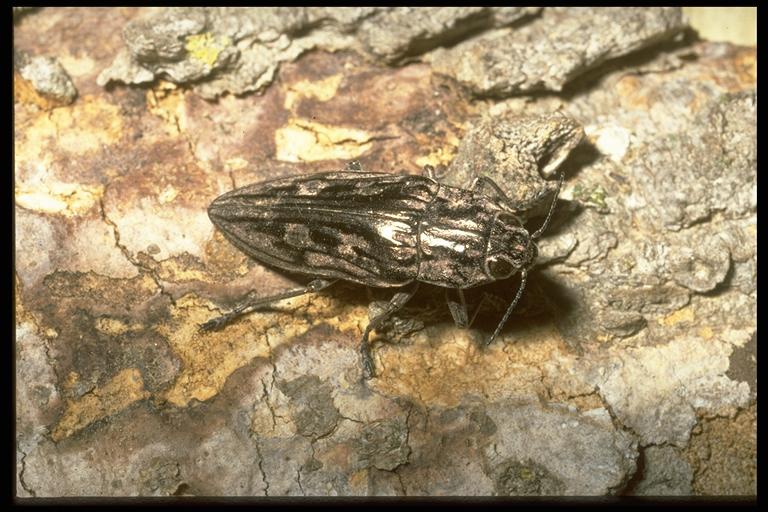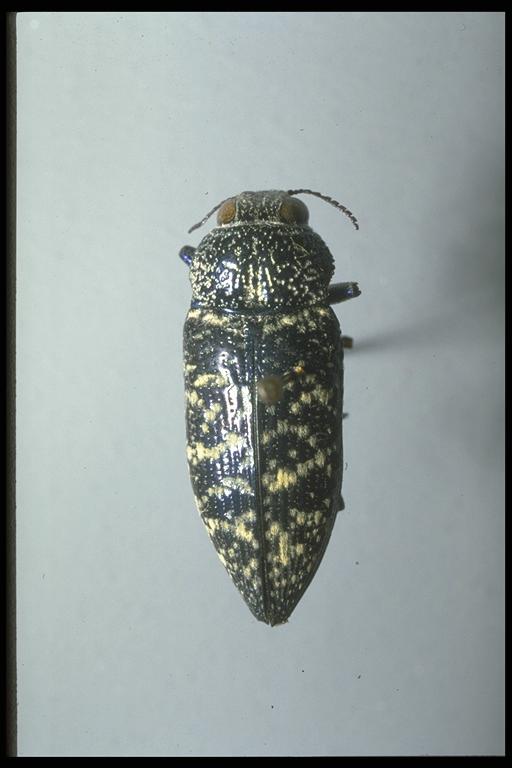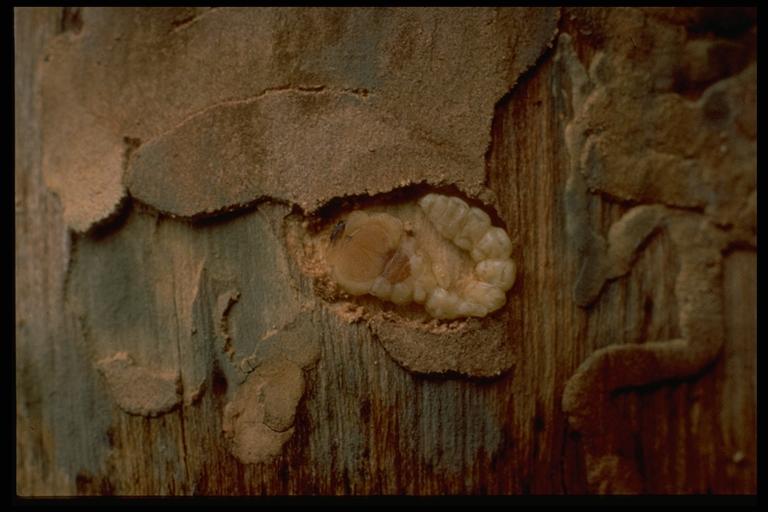
Metallic woodboring beetle, Chalcophora virginiensis (Drury)(Coleoptera: Buprestidae), adult, common in pine trees. Photo by Drees.
Common Name: Woodborer
Scientific Name: Varies
Order: Coleoptera
Description: Adult beetles are elongate or oval with short antennae in most genera, with the leaf-mining genera being nearly circular in appearance. Nearly all adults have some metallic coloration on their bodies, often with the brightest coloration under the wings or on the underside. Chalcophora virginiensis (Drury), is a large black species with a sculptured appearance on the back. Buprestis lineata (Fabricius), has broad red lines on the elytra and a metallic pronotum. These two species often emerge from pine in log homes. Chrysobothris are intermediate in size with a sculptured back and there are a number of species that attack pines and broad-leaved trees. Acmaeodera are most commonly seen on flowers as adults and the irregular bright yellow to orange mixed with blue-black colors let them blend with the flowers. These adults have the wing covers (elytra) united along the back but they can still pull out the wings below and fly well. Agrilus is considered the world’s largest genus with over 8,000 species. Agrilus are elongate and attack twigs or less commonly larger portions of trees. Larvae are elongate grubs with the segments just behind the head (thorax) enlarged (widened) and flattened. They are usually white to cream colored with a darker plate on the thorax. The head is actually mostly hidden and fleshy.
There are many other beetle groups that have wood boring species. Larvae can easily be confused with long horned wood borers but the adults are much different.

A metallic woodboring beetle, Chrysobothris sp. (Coleoptera: Buprestidae), adult. Photo by Jackman.
Life Cycle: Adult beetles are usually short-lived, surviving for a few weeks. Adults emerge in the spring and summer depending on the species. Eggs are laid in crevices in the bark for wood boring species. Larvae develop inside the plant primarily just under the bark for wood borers or inside stems or roots. Leaf-mining species may have several generations per year. However, most species have one generation per year or take multiple years to develop. There are a few records of development over 8 years. Pupation occurs inside the plant.
Habitat and Food Source(s): Mouthparts are for chewing. It is important to know the host plant for a particular species of metallic wood borers. Some of the larger species feed on pines, although most woody plants have at least one species that feeds on it. Larvae usually tunnel just under the bark surface but may go into the heartwood. Tunnels are oval in cross-section and often have a zigzag pattern that increases in width as the larvae grow. Emergence holes of adults are most likely to have a semicircular shape or at least one relatively flat side. Leaf mining species are present on oaks and a few small herbaceous plants where they form short broad leaf mines. Adults of some groups, especially Acmaeodera, are found on flowers where they probably feed on pollen. A few of the adults feed on leaves.
Pest Status: Larvae of most species feed in trunks, branches or twigs of woody plants, usually when the plant is dying or dying; some species remain in wood after it is used as building materials and adults emerge up to several years later; medically harmless.
Collecting and preserving tips: Adults can be collected in the field with a sweep net or a beating sheet held under trees or shrubs. They are best collected on the sunny side of trees in the spring. The larger specimens like Chalcophora, Chrysobothris and Buprestis may be found on freshly cut logs. Adult Acmaeodera can be found on flowers while Agrilus are more common on leaves.

A flatheaded woodborer, (Coleoptera: Buprestidae), larva. Photo by M. E. Rice.
For additional information, contact your local Texas A&M AgriLife Extension Service agent or search for other state Extension offices.
Literature: Baker 1972; Swan & Papp 1972.